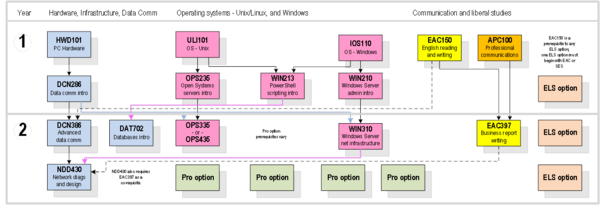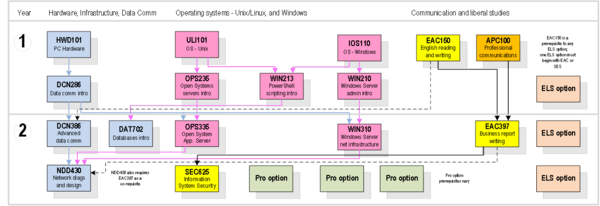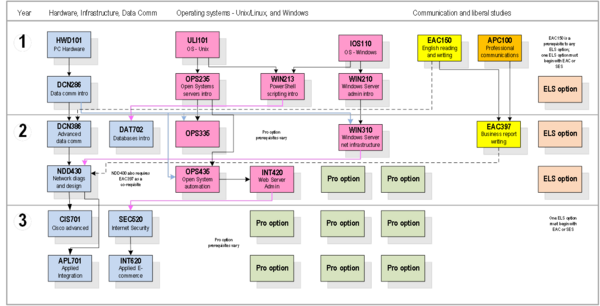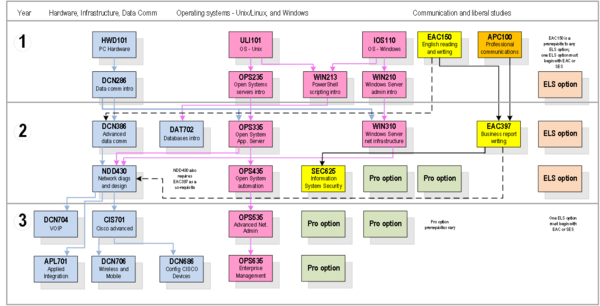Difference between revisions of "CNS / CTY Curriculum Development"
| (27 intermediate revisions by the same user not shown) | |||
| Line 1: | Line 1: | ||
==CNS/CTY Streams (Development Framework)== | ==CNS/CTY Streams (Development Framework)== | ||
| − | The purpose of this resource is to use a WIKI as a repository to create a transparent, efficient on-line framework (tool) to assist in CNS/CTY Curriculum development. This WIKI will branch out into several streams for analysis / development. | + | The purpose of this resource is to use a WIKI as a repository to create a transparent, efficient on-line framework (tool) to assist in CNS/CTY Curriculum development. This WIKI will branch out into several streams for analysis / development. The CNS/CTY PAC (Program Advisory Committee) meetings have been held several times during 2014. This committee consists of management, faculty, industry professionals, and former CNS/CTY students that meet to review and discuss the current curriculum and recommend or advise any changes that may need to be made. It is the intension of this WIKI to provide a collection point for ideas and collaboration between courses for the CNS/CTY program. |
| − | + | ==Curriculum Development Framework by Stream== | |
:* [ [[Hardware]] ] | :* [ [[Hardware]] ] | ||
:* [ [[Database]] ] | :* [ [[Database]] ] | ||
| − | :* [ [http://zenit.senecac.on.ca/wiki/index.php/OPS OPS (Operating Systems)] ] | + | :* [ [http://zenit.senecac.on.ca/wiki/index.php/OPS OPS (Operating Systems)] ] |
:* [ [[Security]] (sideline stream) ] | :* [ [[Security]] (sideline stream) ] | ||
:* [ [[Cloud Computing]] ] | :* [ [[Cloud Computing]] ] | ||
| Line 18: | Line 18: | ||
[ [[CNS/CTY Curriculum: Discussion Transcript]] ] | [ [[CNS/CTY Curriculum: Discussion Transcript]] ] | ||
| − | + | ==Current vs Proposed CNS/CTY Curriculum Maps== | |
| − | + | ===CNS (Click to Enlarge)=== | |
| − | + | {|cellpadding="15" width="40%" | |
| − | |||
| − | |||
| − | |||
| − | + | |- | |
| − | : | + | |[[Image:cns_old.png|thumb|600px|Current Curriculum Map of '''CNS''' diploma programs:<br>'''Winter 2016''']] |
| − | : | + | |[[Image:cns_new.png|thumb|600px|'''Proposed Curriculum Map of CNS diploma program '''.]] |
| − | + | |} | |
| − | |||
| − | + | ===CTY (Click to Enlarge)=== | |
| − | = | ||
{|cellpadding="15" width="40%" | {|cellpadding="15" width="40%" | ||
|- | |- | ||
| − | |[[Image: | + | |[[Image:cty_old.png|thumb|600px|Current Curriculum Map of '''CNS''' diploma programs:<br>'''Winter 2016''']] |
| − | |[[Image: | + | |[[Image:cty_new.png|thumb|600px|'''Proposed Curriculum Map of CNS diploma program '''.]] |
|} | |} | ||
| − | ==The | + | ==Changes to the Lab Environment== |
| + | |||
| + | :A ongoing project to provide students and faculty with a more efficient and flexible lab environment for the school of ICT was launched in the summer semester of 2016. | ||
| + | |||
| + | ===Project Goals:=== | ||
| + | |||
| + | ====Create a platform for testing new technologies within the lab while simultaneously ensuring that the day to day teaching and learning environment is not compromised.==== | ||
| + | |||
| + | :Currently in T4046 we have implemented a dual boot image. Option 1 is to boot to what is currently the universally accepted image for ICT, provided by ITS. It is approximately 190GB in size and contains Windows 8 and all software required to teach a variety of courses throughout ICT. | ||
| + | |||
| + | :Option 2 is to boot to an image that is currently being tested and will replace the current image. It is approximately 40GB in size and contains Windows 10, three different browsers, an SSH terminal, Office software and Vmware workstation. Teachers across ICT have begun to test the delivery of their courses on virtual machines. | ||
| + | |||
| + | ====Create a platform that is not dependent on hardware.==== | ||
| + | |||
| + | :Through the use of Vmware workstation ICT intends to abandon it's somewhat proprietary hardware model which uses IDEX switches and removable drives. CNS/CTY courses will be able to perform and practice installation procedures, OS administration/configuration and any networking functions by creating and virtual machines on their own USB 3.0 connected hardware. Courses in other programs that require a single virtual machine with pre-installed software (CPA/CPD, etc) will create virtual machines for their students and distribute them via a repository. This will not only eliminate the additional hardware currently in use but will create an environment where subtle differences between PCs will not be noticed. | ||
| + | |||
| + | ====Create a platform that can be easily adapted to new technologies as they emerge and become available.==== | ||
| + | |||
| + | :VMware workstation has been chosen for this task as it is a current industry leader in this technology and therefore uses file formats that have become industry standard. We know that there are cloud technologies available but the time required for ITS to deliver a service to us and the immediate needs of the school to improve the quality of our programs and service to the student are not always compatible. We have investigated the viability of being able to port Vmware workstation virtual machines to OpenStack (at the moment, this seems to be the platform of choice for ITS) and concluded that this is viable. This means whatever we are creating now should be applicable to SPACE (Seneca Private Academic Cloud Environment) when it becomes available. | ||
| + | |||
| + | ====Create a platform that gives students the flexibility to work and learn both on and off campus.==== | ||
| + | |||
| + | :Vmware workstation offers a very reasonable academic license fee which will allow us not only to install this software college wide but will allow us to get our students a license for the same software. This will mean that students will be able to do a large amount of their work at home or on any campus without the having to worry about compatibility issues with either software or hardware. | ||
| + | |||
| + | ====Create a platform that can be easily serviced.==== | ||
| + | |||
| + | :Because of it's size and the multitude of services that must be started to accommodate the wide variety of courses it is slow to boot. If a PC needs to be re-imaged, the process takes a long time. The smaller base image will allow ITS to perform more rapid fixes in the event of PCs breaking down. It will also give the school the flexibility to replace/upgrade machines at any time without having to worry about hardware compatibility issues. | ||
| + | |||
| + | ====Create a more secure platform.==== | ||
| + | |||
| + | :Currently to access a computer here at the school for any use a user must log in with their Seneca credentials which gives the user access to the network and forces the computer to map to various drives and network services. Many faculty and students have objected to this when their use of a PC does not always require network access. A Guest account will be enable on the new image to allow students and faculty alike to log in to classroom PCs without having to use their credentials provided the work they need to do does not require network access. This might include faculty wanting to do a presentation in a class with material sourced from local hardware (USB key) or students wanting to do lab work that only required the use of their VMs and internal networks but not the use of the Seneca network. | ||
| + | |||
| + | :This model should also help ITS with their deliver of patches and updates. By having a limited amount of software on the bas image and restricting specific software to specific VMs, ITS should have less trouble with patching, updating and deploying Windows on the base image as it contains less software and therefore is smaller and should have less issues with compatibility. | ||
| + | |||
| + | ==Curriculum Changes== | ||
| + | |||
| + | :Below are the details of planned curriculum changes throughout the OPS stream of the CNS/CTY program based on PAC recommendations, acquisition of new equipment and overall changes to the program structure. | ||
| − | + | ===OPS435=== | |
| + | :It has come to the conclusion of the OPS stream development group that an entire course dedicated to bash shell scripting is unnecessary. OPS235 and OPS335 are in their final stages of redevelopment and the feedback from students and faculty alike is extremely positive. Murray Saul has been working on the OPS 235 and 335 curriculum and sees an opportunity to encompass all of the necessary bash skills our students require within these two courses and ULI101. Although there is already some bash scripting performed in these courses he believes that he can modify the curriculum to meet these requirements. In addition to this Murray is going to move OPS235 and 335 off of the removable hard drives and get the courses running on VMs. We have a tentative completion date for all of this of Spring 2017. | ||
| − | + | :In it's place, OPS435 (we may change the title) is to become a Python programming course for network admins. It is felt that this course will provide more value to the students in terms of job related skills and will better support the upper semester courses. The group wants to start developing this course immediately. Marcel Silva has been mentioned as the best candidate to get this off the ground both as a teacher and a course developer. Andrew Oatley-Willis has volunteered to assist in the development and teaching of this course. Andrew Smith will be leaving us for a year (parental leave) but is willing to teach this course upon his return and will assist in whatever capacity he can. | |
| + | ===OPS535=== | ||
| − | : | + | :Raymond Chan has begun making changes to OPS535 and 635 courses. OPS535 is going to focus on Platform as a service using OpenShift container technology. Students will learn to build and maintain environments that will allow developers to develop, host and scale applications in a cloud environment. |
| − | + | ===OPS635=== | |
| − | : | + | :OPS635 will then focus on the implementation of private cloud infrastructure on bare metal. A recent acquisition of server cabinets an SUN Microsystems servers and the re-allocation of servers and networking hardware acquired by Scott Apted has prompted the construction of a cloud computing lab in T3136. While the details of the construction of this lab are still being worked out we are confident that a lab with these dedicated services will be highly utilized due in part to the changes made in CNS/CTY curriculum. The teaching opportunities that will be presented in this lab will make it attractive to other courses in other programs as well. |
| − | ==Additional Resources== | + | == Additional Resources / Navigation == |
| − | |||
:* Meeting Minutes for CNS/CTY PAC Committee Meetings | :* Meeting Minutes for CNS/CTY PAC Committee Meetings | ||
:* Curriculum Development Forms | :* Curriculum Development Forms | ||
| + | :* [http://zenit.senecac.on.ca/wiki/index.php/ICT_Curriculum_Review/Refresh/Update_-_2012 ICT Curriculum Review 2012] | ||
| + | :* [http://zenit.senecac.on.ca/wiki/index.php/Programming_Stream#Curriculum_Development_Sessions_.282012.29 Updating Programming Stream] (Example of CPA/CPD Curriculum Development on WIKI) | ||
[[Category:Curriculum, OPS Stream]] | [[Category:Curriculum, OPS Stream]] | ||
Latest revision as of 19:06, 11 April 2016
Contents
- 1 CNS/CTY Streams (Development Framework)
- 2 Curriculum Development Framework by Stream
- 3 Overview / Direction
- 4 Current vs Proposed CNS/CTY Curriculum Maps
- 5 Changes to the Lab Environment
- 5.1 Project Goals:
- 5.1.1 Create a platform for testing new technologies within the lab while simultaneously ensuring that the day to day teaching and learning environment is not compromised.
- 5.1.2 Create a platform that is not dependent on hardware.
- 5.1.3 Create a platform that can be easily adapted to new technologies as they emerge and become available.
- 5.1.4 Create a platform that gives students the flexibility to work and learn both on and off campus.
- 5.1.5 Create a platform that can be easily serviced.
- 5.1.6 Create a more secure platform.
- 5.1 Project Goals:
- 6 Curriculum Changes
- 7 Additional Resources / Navigation
CNS/CTY Streams (Development Framework)
The purpose of this resource is to use a WIKI as a repository to create a transparent, efficient on-line framework (tool) to assist in CNS/CTY Curriculum development. This WIKI will branch out into several streams for analysis / development. The CNS/CTY PAC (Program Advisory Committee) meetings have been held several times during 2014. This committee consists of management, faculty, industry professionals, and former CNS/CTY students that meet to review and discuss the current curriculum and recommend or advise any changes that may need to be made. It is the intension of this WIKI to provide a collection point for ideas and collaboration between courses for the CNS/CTY program.
Curriculum Development Framework by Stream
- [ Hardware ]
- [ Database ]
- [ OPS (Operating Systems) ]
- [ Security (sideline stream) ]
- [ Cloud Computing ]
- [ Advanced Data Communications ]
Overview / Direction
Recommendations From Recent PAC Meetings:
[ CNS/CTY Curriculum: Discussion Transcript ]
Current vs Proposed CNS/CTY Curriculum Maps
CNS (Click to Enlarge)
CTY (Click to Enlarge)
Changes to the Lab Environment
- A ongoing project to provide students and faculty with a more efficient and flexible lab environment for the school of ICT was launched in the summer semester of 2016.
Project Goals:
Create a platform for testing new technologies within the lab while simultaneously ensuring that the day to day teaching and learning environment is not compromised.
- Currently in T4046 we have implemented a dual boot image. Option 1 is to boot to what is currently the universally accepted image for ICT, provided by ITS. It is approximately 190GB in size and contains Windows 8 and all software required to teach a variety of courses throughout ICT.
- Option 2 is to boot to an image that is currently being tested and will replace the current image. It is approximately 40GB in size and contains Windows 10, three different browsers, an SSH terminal, Office software and Vmware workstation. Teachers across ICT have begun to test the delivery of their courses on virtual machines.
Create a platform that is not dependent on hardware.
- Through the use of Vmware workstation ICT intends to abandon it's somewhat proprietary hardware model which uses IDEX switches and removable drives. CNS/CTY courses will be able to perform and practice installation procedures, OS administration/configuration and any networking functions by creating and virtual machines on their own USB 3.0 connected hardware. Courses in other programs that require a single virtual machine with pre-installed software (CPA/CPD, etc) will create virtual machines for their students and distribute them via a repository. This will not only eliminate the additional hardware currently in use but will create an environment where subtle differences between PCs will not be noticed.
Create a platform that can be easily adapted to new technologies as they emerge and become available.
- VMware workstation has been chosen for this task as it is a current industry leader in this technology and therefore uses file formats that have become industry standard. We know that there are cloud technologies available but the time required for ITS to deliver a service to us and the immediate needs of the school to improve the quality of our programs and service to the student are not always compatible. We have investigated the viability of being able to port Vmware workstation virtual machines to OpenStack (at the moment, this seems to be the platform of choice for ITS) and concluded that this is viable. This means whatever we are creating now should be applicable to SPACE (Seneca Private Academic Cloud Environment) when it becomes available.
Create a platform that gives students the flexibility to work and learn both on and off campus.
- Vmware workstation offers a very reasonable academic license fee which will allow us not only to install this software college wide but will allow us to get our students a license for the same software. This will mean that students will be able to do a large amount of their work at home or on any campus without the having to worry about compatibility issues with either software or hardware.
Create a platform that can be easily serviced.
- Because of it's size and the multitude of services that must be started to accommodate the wide variety of courses it is slow to boot. If a PC needs to be re-imaged, the process takes a long time. The smaller base image will allow ITS to perform more rapid fixes in the event of PCs breaking down. It will also give the school the flexibility to replace/upgrade machines at any time without having to worry about hardware compatibility issues.
Create a more secure platform.
- Currently to access a computer here at the school for any use a user must log in with their Seneca credentials which gives the user access to the network and forces the computer to map to various drives and network services. Many faculty and students have objected to this when their use of a PC does not always require network access. A Guest account will be enable on the new image to allow students and faculty alike to log in to classroom PCs without having to use their credentials provided the work they need to do does not require network access. This might include faculty wanting to do a presentation in a class with material sourced from local hardware (USB key) or students wanting to do lab work that only required the use of their VMs and internal networks but not the use of the Seneca network.
- This model should also help ITS with their deliver of patches and updates. By having a limited amount of software on the bas image and restricting specific software to specific VMs, ITS should have less trouble with patching, updating and deploying Windows on the base image as it contains less software and therefore is smaller and should have less issues with compatibility.
Curriculum Changes
- Below are the details of planned curriculum changes throughout the OPS stream of the CNS/CTY program based on PAC recommendations, acquisition of new equipment and overall changes to the program structure.
OPS435
- It has come to the conclusion of the OPS stream development group that an entire course dedicated to bash shell scripting is unnecessary. OPS235 and OPS335 are in their final stages of redevelopment and the feedback from students and faculty alike is extremely positive. Murray Saul has been working on the OPS 235 and 335 curriculum and sees an opportunity to encompass all of the necessary bash skills our students require within these two courses and ULI101. Although there is already some bash scripting performed in these courses he believes that he can modify the curriculum to meet these requirements. In addition to this Murray is going to move OPS235 and 335 off of the removable hard drives and get the courses running on VMs. We have a tentative completion date for all of this of Spring 2017.
- In it's place, OPS435 (we may change the title) is to become a Python programming course for network admins. It is felt that this course will provide more value to the students in terms of job related skills and will better support the upper semester courses. The group wants to start developing this course immediately. Marcel Silva has been mentioned as the best candidate to get this off the ground both as a teacher and a course developer. Andrew Oatley-Willis has volunteered to assist in the development and teaching of this course. Andrew Smith will be leaving us for a year (parental leave) but is willing to teach this course upon his return and will assist in whatever capacity he can.
OPS535
- Raymond Chan has begun making changes to OPS535 and 635 courses. OPS535 is going to focus on Platform as a service using OpenShift container technology. Students will learn to build and maintain environments that will allow developers to develop, host and scale applications in a cloud environment.
OPS635
- OPS635 will then focus on the implementation of private cloud infrastructure on bare metal. A recent acquisition of server cabinets an SUN Microsystems servers and the re-allocation of servers and networking hardware acquired by Scott Apted has prompted the construction of a cloud computing lab in T3136. While the details of the construction of this lab are still being worked out we are confident that a lab with these dedicated services will be highly utilized due in part to the changes made in CNS/CTY curriculum. The teaching opportunities that will be presented in this lab will make it attractive to other courses in other programs as well.
- Meeting Minutes for CNS/CTY PAC Committee Meetings
- Curriculum Development Forms
- ICT Curriculum Review 2012
- Updating Programming Stream (Example of CPA/CPD Curriculum Development on WIKI)



